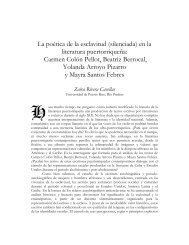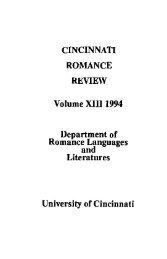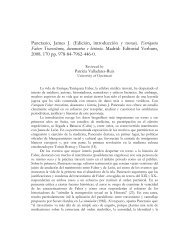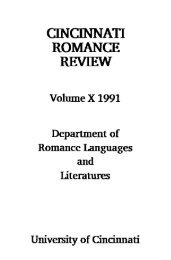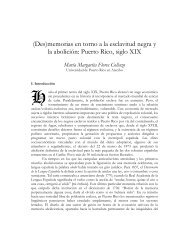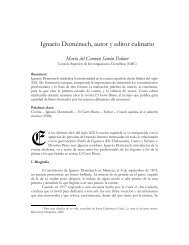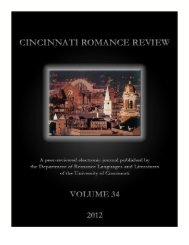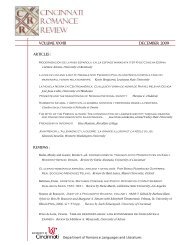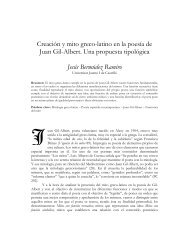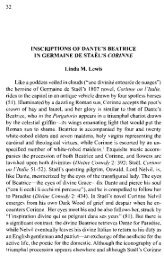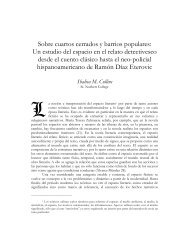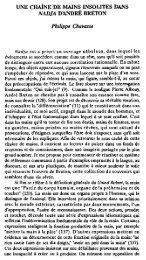Volume 30 (2011) - Cincinnati Romance Review
Volume 30 (2011) - Cincinnati Romance Review
Volume 30 (2011) - Cincinnati Romance Review
Create successful ePaper yourself
Turn your PDF publications into a flip-book with our unique Google optimized e-Paper software.
WRITING AFRICANS OUT OF THE RACIAL HIERARCHY<br />
the “raza cosmica” as a solution for the presence of people of African descent in<br />
Mexico, he argued that the United States would always face the “problem” of “Blacks”<br />
because of Anglo-American refusal to racially intermix (26, 33). This statement, along<br />
with the emphasis on “positive eugenics,” demonstrates that despite Vasconcelos’<br />
attempts to counter North Atlantic denigration of Mexico he could not escape from the<br />
legacy of anti-Africanism in Mexican society or the influence of North Atlantic racism.<br />
Vasconcelos’ contemporary, Manuel Gamio, was also significant in shaping<br />
revolutionary and post-revolutionary thought about racial nationalism. Unlike<br />
Vasconcelos, Gamio’s major treatise on race and nation, Forjando Patria: Pronacionalismo<br />
(Forging a Fatherland), came out in 1916, before he had held any significant government<br />
posts. After moving to the U.S. in 1925 and denouncing corruption in the ministry of<br />
education, Gamio returned to Mexico in the 19<strong>30</strong>s and held various government<br />
positions, including founding and directing the inter-American Indian Institute. Gamio<br />
had trained under anthropologist Franz Boas at Columbia University, and was<br />
influenced by the idea that culture, rather than race, shaped a people’s development and<br />
characteristics (Tenorio Trillo 1175-1178). Recent studies of early 20th century U.S.<br />
social science, such as Henry Yu’s Thinking Orientals, have demonstrated that the use of<br />
“culture” as a tool for understanding society did not eliminate racism, but actually<br />
served to perpetuate it, since “culture” became a convenient substitute for “race” in<br />
what was supposed to be a society evolving toward color blindness (Yu). Due at least<br />
partially to the Boasian influence, but likely to latent racism as well, Gamio did not<br />
advocate literal miscegenation, but instead argued that Mexico’s indigenous people<br />
should be culturally miscegenated. Gamio believed that what made an Indian an Indian<br />
was his culture, not his phenotype.<br />
Like Vasconcelos, Gamio saw his racial theory, usually referred to as indigenismo,<br />
as nationalist and contrary to U.S. scientific racism. Yet it had much in common with<br />
U.S. and European assertions about racial superiority and inferiority. Gamio was an<br />
archeologist, most associated with participating in the early excavation of Teotihuacán<br />
and the Templo Mayor. His interest in the great pre-Hispanic sites was not purely<br />
archeological, however. The architectural triumphs of pre-Hispanic Mexico also offered<br />
Gamio a “great past” to tie to the new Revolutionary Mexican nationalism. He criticized<br />
the Porfirian relegation of all things indigenous to barbarism as negative for the<br />
Mexican psyche (Gamio 102). But this did not mean that Gamio had a positive view of<br />
indigenous people living in the present. On the contrary, he viewed indigenous culture,<br />
religious tradition, and language as inferior. At best indigenous people possessed all of<br />
the merits and shortcomings of Europeans (Gamio 39). Living indigenous people were<br />
worthy of study only for the purpose of achieving mestizaje and by extension national<br />
unity and modernization, according to Gamio.<br />
While Vasconcelos expressed a clearly pejorative view of people of African<br />
descent, Gamio simply refused to address their existence in Mexico. Gamio could not<br />
have been ignorant of Mexico’s population of people of African descent, yet he found<br />
<strong>Cincinnati</strong> <strong>Romance</strong> <strong>Review</strong> <strong>30</strong> (Winter <strong>2011</strong>): 172-183.<br />
179



